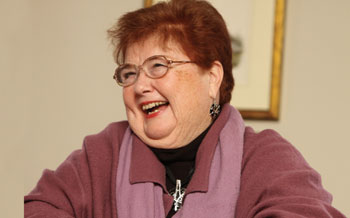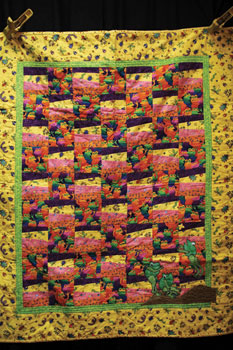Quilting Memories, Sowing Dreams |
| Printer-friendly version | Email this article |
|
She was director of the GLCA Scotland Program and worked with scores of students. But our interview looking back on her Wabash career begins with a quilt. “I brought this because it tells a story,” she says as we spread the fabric on the wall of the media center TV studio. It’s a cacophony of color, with every square populated by cartoonish frogs peeping out at us from a smattering of ladybugs and dragonflies. Nancy sewed it as a lighthearted tribute to the antics of her husband, former Wabash Professor of Biology Bill Doemel. “Students in Bill’s biology course had to dissect a frog, and on the last day of the semester Bill would come to class wearing a frog head I’d made for our son. Bill added green scuba flippers and these ungodly green pajamas!” Another quilt she created reminds her of her mother. “The border is sewn from the fabric of a dress she made for me. Often I make quilts as a way to remember.” It’s a way she came to late in life, the result of a job review in 1999 with then Dean for College Advance-ment Paul Pribbenow. “He said, ‘You work too much and I’m worried about your private life—that you don’t seem to have other things going on that would take you away from work,’” Nancy recalls. “After a couple of days I realized he was probably right—I really should have some other things in my life besides my husband, my son, and my job.” She had long admired the quilting work of Wabash Costume Designer Laura Conners, Dana Fischer, and Mary Lou Mielke. “So I went off to learn, and I especially enjoy that part of it—you never stop learning.” We spread out several more quilts, each wildly different from the next. “People think quilters are crazy. We cut up fabric and then sew the pieces together again. It’s a collaboration between those who made the fabric and the one who collects and puts them all together. “I still take quilting classes—let’s just say it did not come easily,” Nancy says. Which is surprising to hear from a woman so skilled at weaving together disparate people and organizations to make something good and lasting for others. She had planned to become a teacher. One class session she says she’ll never forget: “During my junior year a young man in the senior class committed suicide. Mr. Foster walked into class and read a poem called ‘Richard Cory,’ which includes these lines: ‘…and Richard Cory glittered while he walked…And one calm summer night went home and put a bullet through his head.’ He read that poem and then he stopped and was very quiet. Then he asked, ‘Now, what do you get from that poem?’ It was a powerful moment for me—the first time I understood that poetry and literature are not just something that you read and study, but that speak to your everyday life. “So I wanted to be an English teacher as good as Gene Foster.” Years later, such deep respect for teaching and learning would serve Nancy and her Wabash faculty colleagues well. Growing up in Tiffin, OH, Nancy and Bill dated when she was a high school sophomore and he was a junior. They were married soon after Nancy graduated from Wittenberg College, and she worked as an English teacher in Bloomington while he finished his Ph.D. at Indiana University. Then came Bill’s job offers, including one from Wabash. “Crawfordsville seemed to us most like the town we grew up in. As the wife, I looked at the town and said, ‘This is cool.’” Not so cool was the dearth of English teaching positions open in the area. “I spent the first six months figuring out what it meant to be a stay-at-home housewife. I was climbing the walls by the end of December!” So she started her master’s at Purdue, found out a few months in that she was pregnant, and finished her degree over four years while she and Bill shared the work of raising their son, Chris. She knew she wanted to work, in addition to being a mother. “I needed my brain to be more challenged than the diaper brigade allowed it to be.” Invited by Lucy Brooks to a League of Women Voters meeting, she eventually became the local chapter’s president. Ironically, it was Bill’s first sabbatical in Bloomington that led her to working at Wabash. The professor he worked with needed a coordinator of graduate students. “The professor and I started doing research for a book in values and ethics in science, and to keep his research going, he was getting a lot of National Science Foun-dation grants.” So Nancy learned to write them. “At first he gave me one-on-one lessons in grantsmanship, then I took a course. Over time we got virtually every grant that we worked on. “So here we are in Bloomington—Chris is going to kindergarten, Bill is learning what he wants to learn, and I’m running off to Utah to interview people for this research. It was wonderful networking. I learned about collaboration and working with groups, and then how to write the grant and how to design the action steps.” Following the sabbatical, logistics proved too difficult for Nancy to continue the work. So she approached then-President Lew Salter with a proposal. “I said to Lew, ‘Why don’t you hire me for 10 hours per week? After a year, if I can’t bring in some money, you won’t have lost very much.” President Salter had a counteroffer. Professor Bill Placher ’70 needed an administrative assistant for the GLCA Scotland Program, newly headquartered at Wabash. Would Nancy be interested? “I had studied in Finland the summer between my junior and senior year in high school, and it was a terrific experience,” Nancy says. “So I thought, I know what this is all about. I could do this with one hand tied behind my back.” She started her career at Wabash in July 1979. “Bill became a mentor and, over time, one of my best friends,” she says of Placher. She names the late Dick Ristine ’41—for whom she worked after she moved to Advancement full-time—as the person who most influenced her. “As a role model you couldn’t find a person with more integrity or love for this institution—and what an incredible memory,” she says. A $750,000 grant she wrote for and received from the Howard Hughes Medical Institute while Ristine was director of development is one she finds especially meaningful. She worked with her husband and Professor David Polley on the project. “It sent our faculty off to connect what they were doing with the biomedical community. It was the beginning of what is today the major we offer in biochemistry.” “There are many people doing the work I do who will tell you they submitted a whole lot more proposals than I have,” she says. “But I’ve always thought what’s more important is that you spend the time to find the right funding source. You come to know what they want, and they have confidence in you as an institution. “I’ve always sought fewer grants but better quality relationships.” She believes strong relationships are also the lifeblood of Wabash College. “What is most essential at Wabash has less to do with which classes people take and more to do with the relationships students have with the faculty members who teach. It’s not so much the content of the coursework as it is the relationships that lead students to want to continue to learn throughout their lives.” In the final months of her career at Wabash, Nancy smiles as she recalls coming across old notes from those she has worked with on the many grants she has written. “These people have been such wonderful collaborators. Together we’ve made it possible for students to experience this College in ways that somehow changed their lives. “I came in early and stayed late because it seemed to me not just my work, but my reason for being. And that’s what a calling is—the feeling that what I do makes a difference for somebody else, and that I do that for a purpose rather than the paycheck at the end of the month.” Professor Bill Doemel steps into the media center studio for his own retirement interview a few minutes after Nancy leaves. We gather up her quilts and place them on a table for him to carry home afterward. Just for fun, we leave up the frog quilt Nancy made celebrating Bill’s biology class antics. It makes a colorful backdrop for the camera and a reminder that some of his most memorable moments—and the College’s—would not have happened without her.
|

 In 31 years working for the College, Nancy Doemel raised more than $30 million for everything from pianos in the Fine Arts Center to faculty/student research labs to McGregor lectures to summer science and retention programs to the renovation of Lilly Library.
In 31 years working for the College, Nancy Doemel raised more than $30 million for everything from pianos in the Fine Arts Center to faculty/student research labs to McGregor lectures to summer science and retention programs to the renovation of Lilly Library. “I had incredibly good English teachers in high school, and my very best was Gene Foster.”
“I had incredibly good English teachers in high school, and my very best was Gene Foster.”